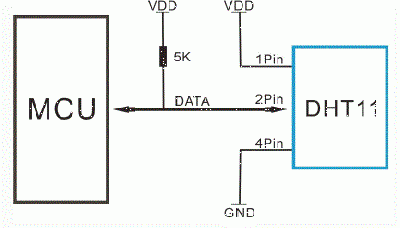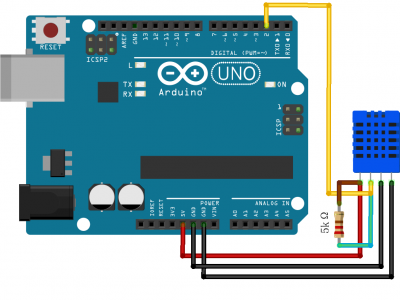DHT11
Introduction
This DHT11 Temperature and Humidity Sensor features a calibrated digital signal output with the temperature and humidity sensor complex. Its technology ensures the high reliability and excellent long-term stability. A high-performance 8-bit microcontroller is connected. This sensor includes a resistive element and a sense of wet NTC temperature measuring devices. It has excellent quality, fast response, anti-interference ability and high cost performance advantages.
Each DHT11 sensors features extremely accurate calibration of humidity calibration chamber. The calibration coefficients stored in the OTP program memory, internal sensors detect signals in the process, we should call these calibration coefficients. The single-wire serial interface system is integrated to become quick and easy. Small size, low power, signal transmission distance up to 20 meters, making it a variety of applications and even the most demanding applications. The product is 4-pin single row pin package. Convenient connection, special packages can be provided according to users need.
Specification
- Supply Voltage: +5 V
- Temperature range :0-50 °C error of ± 2 °C
- Humidity :20-90% RH ± 5% RH error
- Interface: Digital
Digram
Sample Code
We recommendded to use the third demo code here, because it comes from arduino site.
Demo code 1
#define DHT11_PIN 0 // define anlog port 0
byte read_dht11_dat()
{
byte i = 0;
byte result=0;
for(i=0; i< 8; i++)
{
while(!(PINC & _BV(DHT11_PIN)))
{
}; // wait forever until anlog input port 0 is '1' (NOTICE: PINC reads all the analog input ports
//and _BV(X) is the macro operation which pull up positon 'X'to '1' and the rest positions to '0'. it is equivalent to 1<<X.)
delayMicroseconds(30);
if(PINC & _BV(DHT11_PIN)) //if analog input port 0 is still '1' after 30 us
result |=(1<<(7-i)); //this position is 1
while((PINC & _BV(DHT11_PIN))); // wait '1' finish
}
return result;
}
void setup()
{
DDRC |= _BV(DHT11_PIN); //let analog port 0 be output port
PORTC |= _BV(DHT11_PIN); //let the initial value of this port be '1'
Serial.begin(9600);
Serial.println("Ready");
}
void loop()
{
byte dht11_dat[5];
byte dht11_in;
byte i;// start condition
PORTC &= ~_BV(DHT11_PIN); // 1. pull-down i/o pin for 18ms
delay(18);
PORTC |= _BV(DHT11_PIN); // 2. pull-up i/o pin for 40us
delayMicroseconds(1);
DDRC &= ~_BV(DHT11_PIN); //let analog port 0 be input port
delayMicroseconds(40);
dht11_in = PINC & _BV(DHT11_PIN); // read only the input port 0
if(dht11_in)
{
Serial.println("dht11 start condition 1 not met"); // wait for DHT response signal: LOW
delay(1000);
return;
}
delayMicroseconds(80);
dht11_in = PINC & _BV(DHT11_PIN); //
if(!dht11_in)
{
Serial.println("dht11 start condition 2 not met"); //wair for second response signal:HIGH
return;
}
delayMicroseconds(80);// now ready for data reception
for (i=0; i<5; i++)
{
dht11_dat[i] = read_dht11_dat();
} //recieved 40 bits data. Details are described in datasheet
DDRC |= _BV(DHT11_PIN); //let analog port 0 be output port after all the data have been received
PORTC |= _BV(DHT11_PIN); //let the value of this port be '1' after all the data have been received
byte dht11_check_sum = dht11_dat[0]+dht11_dat[1]+dht11_dat[2]+dht11_dat[3];// check check_sum
if(dht11_dat[4]!= dht11_check_sum)
{
Serial.println("DHT11 checksum error");
}
Serial.print("Current humdity = ");
Serial.print(dht11_dat[0], DEC);
Serial.print(".");
Serial.print(dht11_dat[1], DEC);
Serial.print("% ");
Serial.print("temperature = ");
Serial.print(dht11_dat[2], DEC);
Serial.print(".");
Serial.print(dht11_dat[3], DEC);
Serial.println("C ");
delay(2000); //fresh time
}
Code 2
This code contributed by:Camel
#define dht11_pin 14 //Analog port 0 on Arduino Uno
//#define dht11_pin 54 //Analog port 0 on Arduino Mega2560
byte read_dht11_dat()
{
byte i = 0;
byte result=0;
for(i=0; i< 8; i++)
{
while (!digitalRead(dht11_pin));
delayMicroseconds(30);
if (digitalRead(dht11_pin) != 0 )
bitSet(result, 7-i);
while (digitalRead(dht11_pin));
}
return result;
}
void setup()
{
pinMode(dht11_pin, OUTPUT);
digitalWrite(dht11_pin, HIGH);
Serial.begin(9600);
Serial.println("Ready");
}
void loop()
{
byte dht11_dat[5];
byte dht11_in;
byte i;// start condition
digitalWrite(dht11_pin, LOW);
delay(18);
digitalWrite(dht11_pin, HIGH);
delayMicroseconds(1);
pinMode(dht11_pin, INPUT);
delayMicroseconds(40);
if (digitalRead(dht11_pin))
{
Serial.println("dht11 start condition 1 not met"); // wait for DHT response signal: LOW
delay(1000);
return;
}
delayMicroseconds(80);
if (!digitalRead(dht11_pin))
{
Serial.println("dht11 start condition 2 not met"); //wair for second response signal:HIGH
return;
}
delayMicroseconds(80);// now ready for data reception
for (i=0; i<5; i++)
{ dht11_dat[i] = read_dht11_dat();} //recieved 40 bits data. Details are described in datasheet
pinMode(dht11_pin, OUTPUT);
digitalWrite(dht11_pin, HIGH);
byte dht11_check_sum = dht11_dat[0]+dht11_dat[2];// check check_sum
if(dht11_dat[4]!= dht11_check_sum)
{
Serial.println("DHT11 checksum error");
}
Serial.print("Current humdity = ");
Serial.print(dht11_dat[0], DEC);
Serial.print("% ");
Serial.print("temperature = ");
Serial.print(dht11_dat[2], DEC);
Serial.println("C ");
delay(2000); //fresh time
}
Code 3
Code From: http://playground.arduino.cc/Main/DHT11Lib
#include <dht11.h>
dht11 DHT11;
#define DHT11PIN 3 //DHT11 PIN 3 connect to UNO 3
void setup()
{
Serial.begin(115200);
Serial.println("DHT11 TEST PROGRAM ");
Serial.print("LIBRARY VERSION: ");
Serial.println(DHT11LIB_VERSION);
Serial.println();
}
void loop()
{
Serial.println("\n");
int chk = DHT11.read(DHT11PIN);
Serial.print("Read sensor: ");
switch (chk)
{
case DHTLIB_OK:
Serial.println("OK");
break;
case DHTLIB_ERROR_CHECKSUM:
Serial.println("Checksum error");
break;
case DHTLIB_ERROR_TIMEOUT:
Serial.println("Time out error");
break;
default:
Serial.println("Unknown error");
break;
}
Serial.print("Humidity (%): ");
Serial.println((float)DHT11.humidity, 2);
Serial.print("Temperature (oC): ");
Serial.println((float)DHT11.temperature-2, 2);
delay(2000);
}
Code 4
Documents
Read the datasheet on this page.

